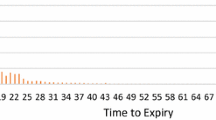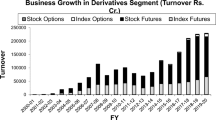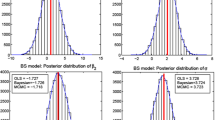Abstract
This paper empirically examines the performance of Black-Scholes and Garch-M call option pricing models using call options data for British Pounds, Swiss Francs and Japanese Yen. The daily exchange rates exhibit an overwhelming presence of volatility clustering, suggesting that a richer model with ARCH/GARCH effects might have a better fit with actual prices. We perform dominant tests and calculate average percent mean squared errors of model prices. Our findings indicate that the Black-Scholes model outperforms the GARCH models. An implication of this result is that participants in the currency call options market do not seem to price volatility clusters in the underlying process.
Similar content being viewed by others
References
Amin, K. and R. Jarrow, “Pricing Foreign Currency Options under Stochastic Interest Rates.” Journal of International Money and Finance 10(3), 310–329 (1991).
Bates, D., “Dollar Jump Fears, 1984–1992: Distributional Abnormalities Implicit in Currency Futures options.” Journal of International Money and Finance 15, 65–93 (1996a).
Bollerslev, T., R. Y. Chou and K. F. Kroner, “ARCH Modeling in Finance: A Review of the Theory and Empirical Evidence” Journal of Econometrics 52, 5–59 (1992).
Chriss, Neil A., Black-Scholes and Beyond: Option Pricing Model. Winnetka: Investing Online, 1995.
Christofferson, P. and K. Jacobs, “The Importance of the Loss Function in Option Pricing,” Working Paper, McGill University, 2001.
Duan, J.-C., “The GARCH Option Pricing Model.” Mathematical Finance 5(1), January, 13–32 (1995).
Duan, J.-C. and J. G. Simonato, “Empirical Martingale Simulation for Asset Prices.” Management Science 49(4), 1218–1233 (1998).
Duan, J.-C. and J. Z. Wei, “Pricing Foreign Currency and Cross-Currency Options under GARCH.” Journal of Derivatives Fall, 51–63 (1999).
Emanuel, D. and J. D. Macbeth, “Further Results on the Constant Elasticity of Variance Call Option Pricing Model.” Journal of Financial and Quantitative Analysis November 533–554 (1982).
Feigner, G. and B. Jacquillant, “Currency Option Bonds, Puts and Calls on Spot Exchange and the Hedging of Contingent Foreign Earnings.” The Journal of Finance 34(5), 1129–1139 (1979).
Fisher, B. and M. Scholes, “The Pricing of Options and Corporate Liabilities.” Journal of Political Economy 81, 637–659 (1973).
Fujihara, R and K. Park, “The Probability Distribution of Futures Prices in the Foreign Exchange Market: A Comparison of Candidate Processes.” Journal of Futures Markets 623–641 (1990).
Heston, S., “A Closed Form Solution for Options with Stochastic Volatility, with Applications to Bonds and Currency Options.” Review of Financial Studies 6, 327–343 (1993).
Heston, S. and S. Nandi, “A Closed-Form GARCH Option Valuation Model.” Journal of Financial Review 13(3), 585–625 (2000).
Hilliard, J. E., J. Madura and A. L. Tucker, “Currency Option with Stochastic Domestic and Foreign Interest Rates.” Journal of Financial and Quantitative Analysis 26(2), 139–151 (1991).
Hsieh, D., “The Statistical Properties of Daily Exchange Rates: 1974-1993.” Journal of International Economics 24, 129–145 (1988).
Johnston, K. and E. Scott, “The Statistical Distribution of Foreign Exchange Rates: Dependent vs. Independent Models.” Journal of Financial and Strategic Decisions 12(2), 39–49 (1999).
Kluger, P. and C. Lenz, “Chaos, ARCH and the Foreign Exchange Market: Empirical Results from Weekly Data.” Unpublished Manuscript, Volswirtschaftliches Institut, Zurich, 1990.
Macbeth, J. D. and L. Merville “Test of Black-Scholes and Cox Call Option Valuation Models.” Journal of Finance 35(2), 285–301 (1980).
McCurdy, T. H. and I. G. Morgan, “Testing the Martingale Hypothesis in Deutsche Mark Futures with Models Specifying the Form of Heteroscedasticity.” Journal of Applied Econometrics 3, 187–202 (1988).
Taylor, S., Modeling Financial Time Series. New York: Wiley, 1986.
Tucker, A. L. and D. R. Peterson, “Tests of the Black-Scholes and Constant Elasticity of Variance Currency Call Option Valuation Models.” Journal of Financial Research 11(3), 201–213 (1988).
Tucker, A. and J. Z. Wei, “Power Currency options.” Global Finance Journal 8(2), 167–180 (1997).
Author information
Authors and Affiliations
Corresponding author
Rights and permissions
About this article
Cite this article
Harikumar, T., de Boyrie, M.E. & Pak, S.J. Evaluation of Black-Scholes and GARCH Models Using Currency Call Options Data. Review of Quantitative Finance and Accounting 23, 299–312 (2004). https://doi.org/10.1023/B:REQU.0000049318.78363.3c
Issue Date:
DOI: https://doi.org/10.1023/B:REQU.0000049318.78363.3c




